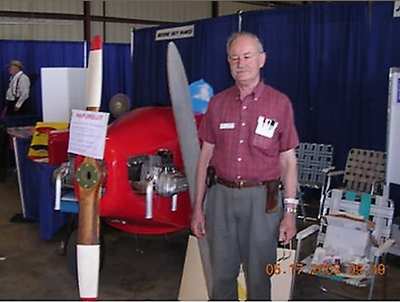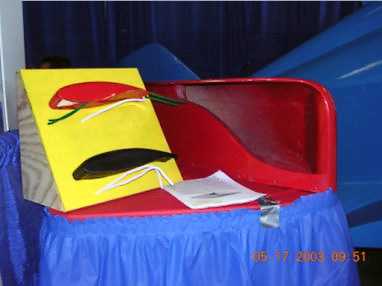Thu, May 22, 2003
Not When It Is A Vorten Tip!
By ANN Correspondent Juan Jimenez
One of the things we like about the regional fly-ins is that
there is always some cool product that doesn't make it to the
larger shows. The SWRFI show was no exception, and this time we got
a look at the Vorten Tip.

The Vorten Tip is a patented wingtip vortex attenuating device
developed from a concept tested in the Purdue University wind
tunnel. It was designed by Ed Johnstone of Johnstone Aero out
of San Antonio, TX. We all know that a lifting surface always has
an associated induced drag which produces a vortex that trails
behind it. Student pilots are taught about wingtip vortices, and
those of us who fly in and out of airports servicing larger
aircraft hear about them from ATC all the time.
The Vorten Tip takes air into an inlet located at the highest
pressure point on the airfoil, forces that high energy air
through an aerodynamically designed plenum chamber and extrudes it
through a reduced-area opening at the trailing edge. If you are
familiar with the design of the P-51 Mustang cooling air scoop, you
know what happens at the exit point - the air leaves at a much
higher velocity than when it came in. With the Vorten Tip, this
effect modifies the "helix angle" associated with the vortex by
stretching it out. This has the effect of reducing induced drag,
which is of course "a good thing."

So what does this all mean? The way Mr. Johnstone explains it,
the Vorten Tip, which can be adapted to just about any "Hershey
Bar" style wing, improves climb and short field performance. It
also improves cruise speed at higher altitudes. Flight testing has
been performed so far on a modified Piper Cherokee PA28-140. The
testing has documented a 100 FT/MIN increase in rate of climb.
Continued testing is being performed in order to optimize the inlet
and outlet configurations.
An application for an STC has already been filed with the FAA to
install the Vorten Tip on Piper Cherokees, and STC's for other
aircraft are planned once the first one is completed.
FMI: Ed Johnstone, (210) 496-3847, ehjjaco@aol.com
More News
With Testing Soon Complete, Launch Preparations Begin in Earnest Sierra Space's Dream Chaser has been put through the wringer at NASA's Glenn Armstrong Test Facility in Ohio, but w>[...]
Takeoff Roll The process whereby an aircraft is aligned with the runway centerline and the aircraft is moving with the intent to take off. For helicopters, this pertains to the act>[...]
“We’re proud of the hard work that went into receiving this validation, and it will be a welcome relief to our customers in the European Union. We couldn’t be mor>[...]
"Aircraft Spruce is pleased to announce the acquisition of the parts distribution operations of Wag-Aero. Wag-Aero was founded in the 1960’s by Dick and Bobbie Wagner in the >[...]
IDENT Feature The special feature in the Air Traffic Control Radar Beacon System (ATCRBS) equipment. It is used to immediately distinguish one displayed beacon target from other be>[...]
 Sierra Space Repositions Dream Chaser for First Mission
Sierra Space Repositions Dream Chaser for First Mission ANN's Daily Aero-Term (05.10.24): Takeoff Roll
ANN's Daily Aero-Term (05.10.24): Takeoff Roll Aero-News: Quote of the Day (05.10.24)
Aero-News: Quote of the Day (05.10.24) Aero-News: Quote of the Day (05.11.24)
Aero-News: Quote of the Day (05.11.24) ANN's Daily Aero-Term (05.11.24): IDENT Feature
ANN's Daily Aero-Term (05.11.24): IDENT Feature




